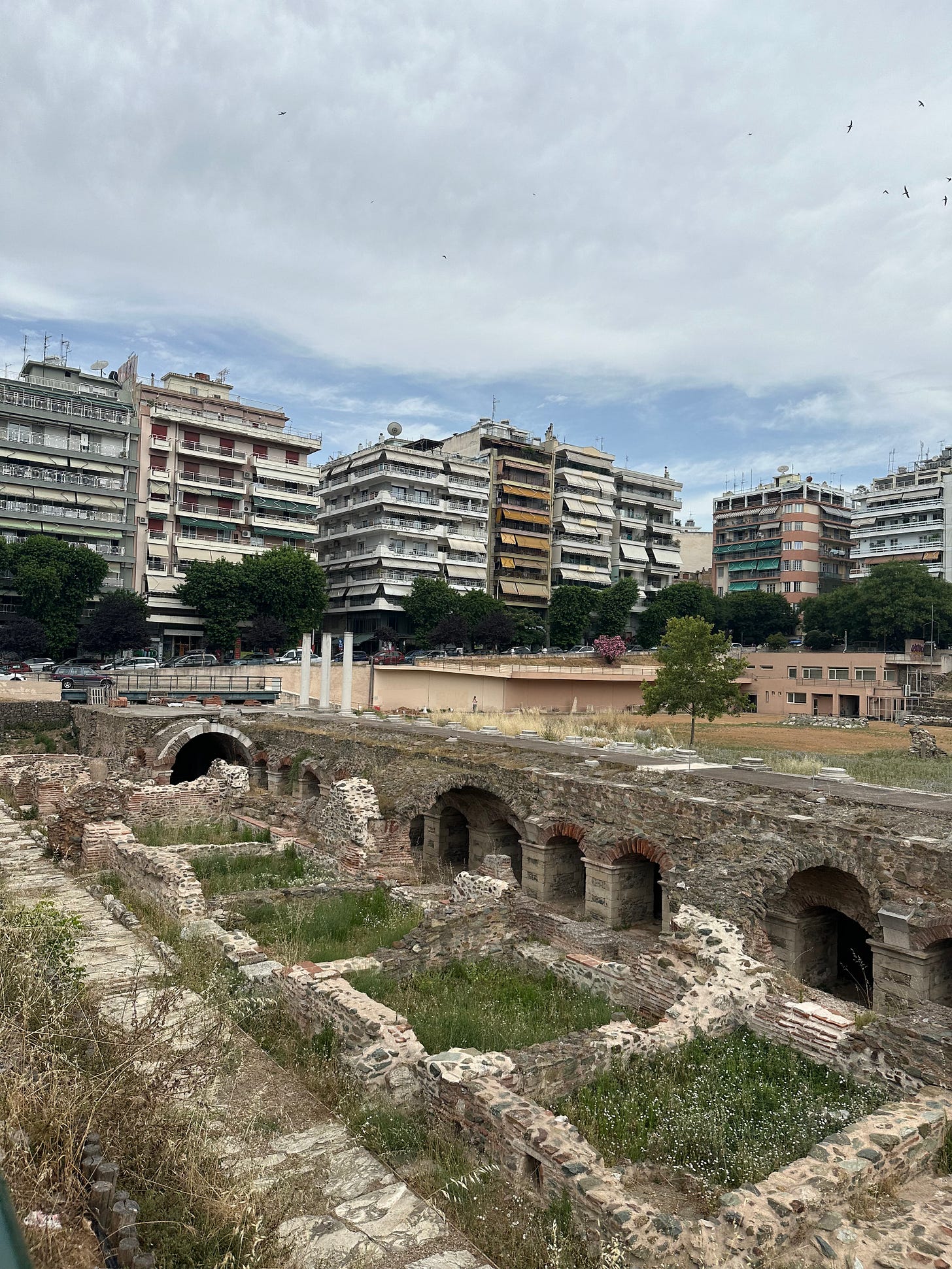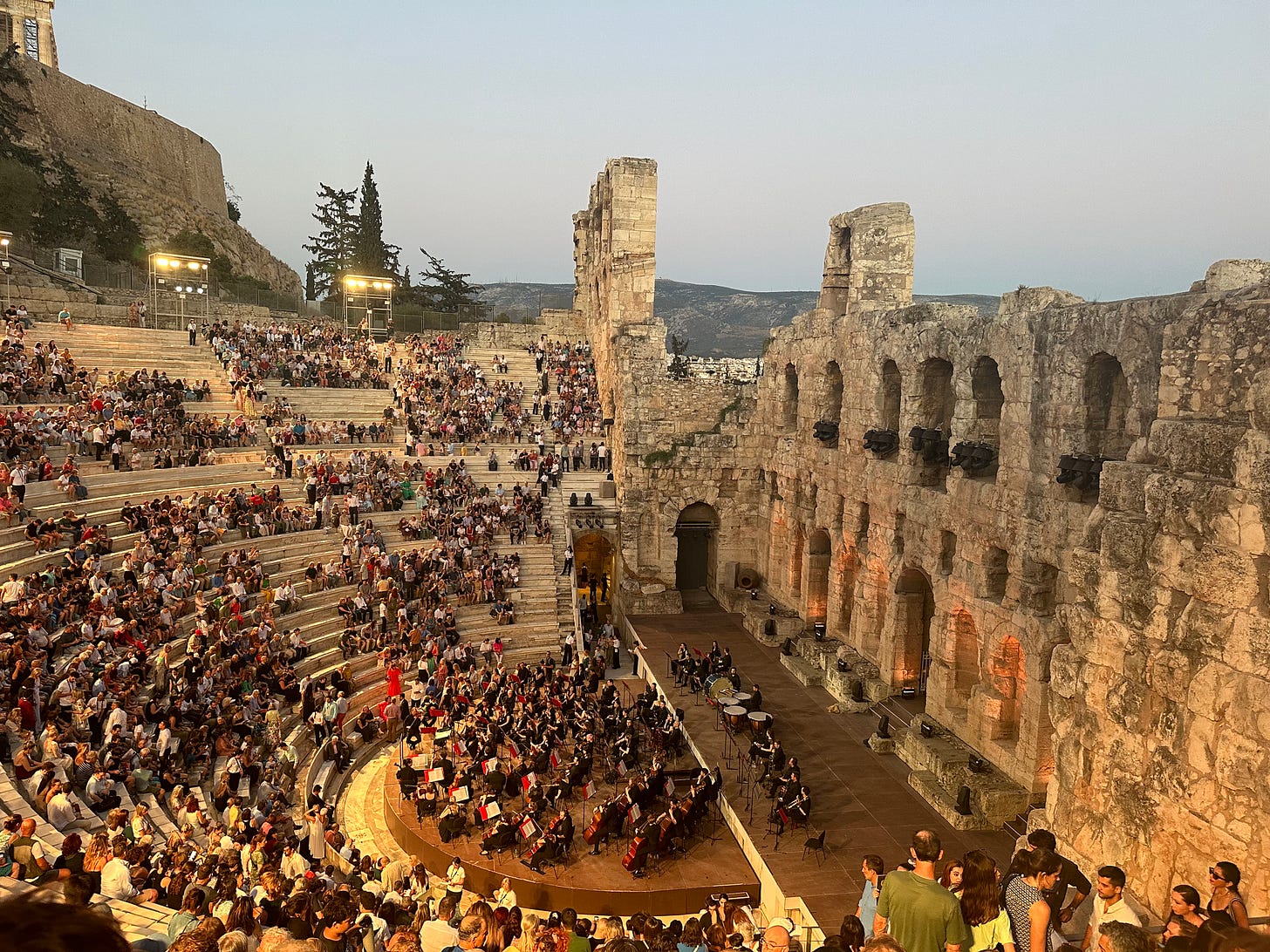Read last summer’s version of “how do we know what is real”
In Greece last month, the students kept saying, “This doesn’t feel real.” At the Parthenon. At the ruins of Delphi. At the temple of Poseidon. “Feels fake,” they shrugged. And they didn’t mean it in an awestruck, this-water-is-too-blue-to-be-believable kind of way. They were simply unmoved. They were sipping cokes from bottles, and obsessed with stray cats, and a reggae cover of U2 played over the cafe speakers (still not what I’m looking for), and then Paul Enka singing “Wonderwall,” and I wondered why the ruins seemed fake to them.
*
It was hot – so hot – and we hiked along roads lined with the same pink mountain laurel that we’d left in Asheville, and we hiked up dry, rocky mountains, and of course the high schoolers had refused to carry their water bottles, and kept stealing sips from mine until all we could taste was dust. We looked out at the views, and TS Eliot murmured in my mind, “Unreal City…”
Here is no water but only rock
Rock and no water and the sandy road
The road winding above among the mountains
Which are mountains of rock without water
And
What are the roots that clutch, what branches grow
Out of this stony rubbish? Son of man,
You cannot say, or guess, for you know only
A heap of broken images, where the sun beats,
And the dead tree gives no shelter, the cricket no relief,
And the dry stone no sound of water.
A heap of broken images.
*
The last time I went to Europe, it was Italy, January 2016, and I was accompanying first year college students from a school in the middle-of-nowhere Midwest, a town you’ve never heard of. I thought a lot on that trip about the differences between Upland, Indiana, and Florence, Italy. I thought about Walker Percy’s idea in The Moviegoer that “certified places” – those places that we’ve seen on the silver screen – feel more real, more important to us than those that haven’t been filmed or fictionalized. I thought he was right. (And I thought it was a problem.)
But this time, the places that had been pictured on the screen seemed to be less real to the students, not more. Maybe Percy was right in the sixties; and maybe now it’s started to flip, now that we carry little silver screens in our pockets. Maybe now the places that seem real to us are places we haven’t seen before, places that have never been diminished into just a pocket sized movie or a meme.
*
Peter wonders if globalization has something to do with the kids’ sense that none of this is “real.” He’s just back from Ethiopia, where he saw three Coldstone Creameries.
*
Peter is also reading a book about adolescent brain development. He tells me that one of the effects marijuana use has on the teenage brain is that it shrinks the brain’s capacity for wonder and amazement. Dulled senses, diminishing returns. Exposing yourself to a manufactured wonder so much that you can’t recognize – you’re no longer astounded by – what is real.
That feels truly tragic to me. And I wonder if our little pocket screens are doing it to us, too.
I think of The Silver Chair, and the people living underground who believe that the sun is just a myth made by people who imagine bigger lamps.
*
Or perhaps the students are just savvy observers of the world.
What I mean is, of course they’re absolutely right: the Parthenon isn’t real. Over the last two thousand years, it’s been continuously remodeled, rebuilt, and reconceived.
In the best book I’ve read about all this, A Map of Future Ruins by Lauren Markham, she notes that “though it is most often described as a temple erected under the politician Pericles in the first century BCE to honor the city’s patron goddess, Athena, since the first of its stones was laid the Parthenon has also served as a church, a mosque, an arms repository – and perhaps even as a temple commemorating human sacrifice.” 1
The parthenon underwent a massive restoration less than fifty years ago – a restoration that purposefully stripped away all the layers of what it had been, to present an unvarnished “original” structure.
The classical statues we visited, statues of Apollo and Aphrodite? They originally had color. But they've been “restored” in pure white. The Nazis liked them that way, too.
Markham quotes my undergraduate professor Craig Kallendorf on the “nesting mythologies” of Greece: “Each postclassical age recreates the classical past as part of its effort to see back into it.”
Perhaps what the students mean when they say it doesn’t feel real is that they can sense that they’re only seeing part of the story, a part purposefully manufactured as a project of nationalism.
They don’t know that ancient Greek-speakers had no conception of themselves as having a shared “Greek” identity; that there was a civil war in Greece seventy years ago; that thousands of refugees have sought refuge on Greece’s shores in the last decade; or any number of the layers of history and identity here, or how the myths have been repurposed by the “western” world. But maybe they can sense it.
*
One night in Athens, four of our students sat outside the Odeon of Herodes Atticus, just under the Parthenon, yearning. Inside, an orchestra and special guests were performing in honor of celebrated Greek composer Mimis Plessas, aged 99. At the intermission, the kids noticed that ticketholders who came out were given a small piece of colored paper as their entry ticket back in. And they also noticed that not everyone was returning for the second half. So they scoured trash cans, coming up with two return tickets, and then went up to strangers, begging, until they had enough colored slips to get in.
It was music they’d never heard – opera and classical and jazz, all composed by Plessas – but the whole Greek crowd around them was singing along.
Whatever else happened in Greece, I think that was real.
Three Things
That cover of Wonderwall was actually good, though? I was sitting on the balcony of phileo when it played, and if you go to Delphi, you need to get a drink there — the owner is an artist.
I do know that I’m extremely late to this, but I’ve finally been listening to Just Kids by Patti Smith on audiobook (it’s included in Spotify premium), and loving it.
Though I’ve not yet watched The Chosen, I’ve appreciated some of the historical work Dr. Laura Robinson has been doing on the show — you might, too.
Finally, I wish you all a very brat summer (by which I mean read Augustine and think about the ways the damages of sin are passed on…)
Dangerous Territory is now available in an updated second edition and as an audiobook! Buy it in paperback or ebook at Bookshop, Amazon, or Barnes and Noble.
Where Goodness Still Grows is available wherever books are sold.










“back on my epistemology bullshit” YES. YES. THIS IS WHAT THE PEOPLE WANT
When I was in Athens, it wasn't for tourism, so I took in the historical sights occasionally, and never actually made it up the Acropolis. Athen's air quality is often very poor. But the day I visited the Acropolis museum, the air was clear as crystal. The clarity was so unreal, so stunning, that I kept turning from the reconstructed Parthenon frieze to gaze out the windows over the city.